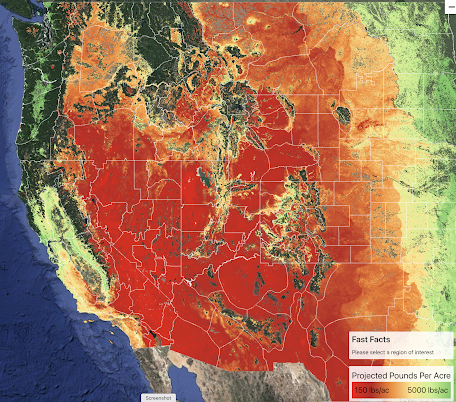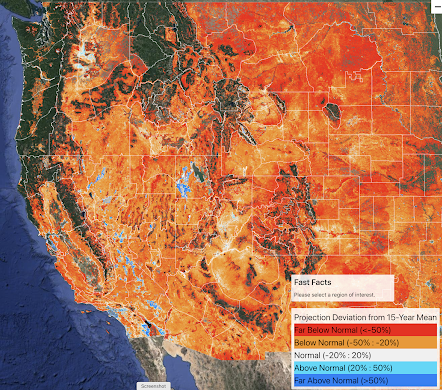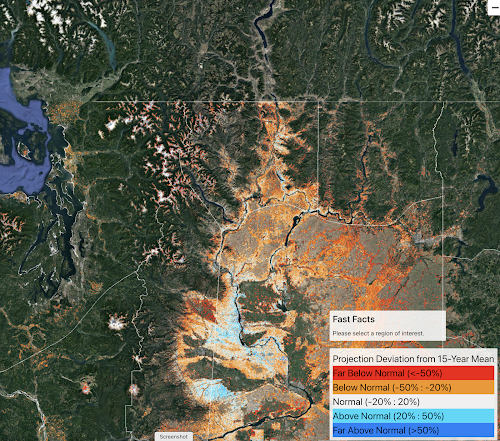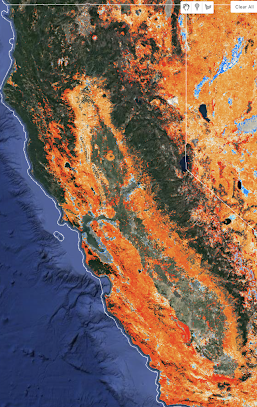Grasses and small shrubs play a critical role in western wildfires since they can act as tinder for the larger fuels, such as dead or living trees, or can ignite man-provided fuels including wooden structures.
Grasses and herbaceous fuels dry out rapidly in late spring and summer and are easily ignited. Fire can move fast in grass and ignite the understory vegetation of forests, which act as ladder fuels into the tree canopies.
The importance of grass and annual vegetation in spreading and initiating fire complicates the relationship of wildfires to climate. For example, wet/cool springs can result in bountiful grass growth, which can lead to more wildfire during the subsequent summer even if the summer has normal temperature and precipitation. Grasses can also make a forest more vulnerable to human ignition of fires, such as the Camp Fire that destroyed Paradise California as a failing electrical tower ignited the grass below.
A variety of state and federal agencies monitor the abundance of grass, information that can provide important insights into the upcoming wildfire season. The amount of grass gives a big hint about future wildfire potential.
So let's check out the current grass situation in the western U.S. and judge the implications for the coming summer!
There is a wonderful site called fuelcast.net, run by the USDA Forest Service.
The current fuel situation from the website is shown below, with the lowest values in the reddish color. Less fuel in the desert southwest, but higher amount in the moister interior of California and eastern Washington.
But what you REALLY want to know is how different the current grass/bush situation is compared to normal. For example, more grass than normal would produce an enhanced fire threat.
You can find the answer below, from the same website. Because of the dry winter and spring, most of the southwest has below-normal grass amounts. But NOT everywhere. Some portions of eastern Washington have more grass than normal.
To show this more clearly, below is a close-up view of eastern Washington. Some areas, such as around Yakima, have above-normal grass amounts.
Why enhanced grass there? Probably because it has been wetter than normal for the past 90 days (see below).
So even if we have a normal summer in terms of temperature and precipitation, the potential for grass fires may be enhanced in the region around Yakima in August and September, and the enhanced threat extends into the nearby lower elevation forests.
The importance of above-normal grass growth was highlighted in April, as large fires occurred in New Mexico near the city of Las Vegas. A USDA Forest Service fire expert, Matt Reeves, had previously noted excessive and unusual grass growth in the area due to a wetter than normal Southwest Monsoon situation last summer. This led to excessive grass growth that he warned had the potential to enhance wildfire in that area. He also noted the danger of having a grass understory with trees above. And then on April 6th, a prescribed burn was initiated when strong winds were forecast (a bad idea). The result was a major fire (the Hermits Peak fire), which has now burned over 300,000 acres.
What does the current grass situation suggest for California this summer?
The difference from normal for the amount of grass is shown below for the state. Because of the dry winter/spring resulting from La Nina, most of California has below-normal amounts of seasonal grass, which will work against the fire threat. But you can bet there still will be fires.
In summary, wildfire occurrence is the result of the complex interaction between land use, the previous growth of light fuels such as grass, temperature and precipitation both before and during the fire season, winds, and much more. Global warming (a.k.a., climate change) is only one component of the fire equation, and not necessarily the most important one.








Thanks, Cliff. Living in Wenatchee we have enjoyed the cool spring with much more abundant wildflowers lasting much longer. And the green that is slowly turning a toast brown as the cheet grass dries. Wildfires are a yearly occurrence here with grassy acreage burning very quickly and creating smoky days. Homes are allowed to be built on these grassy hills
ReplyDeleteThere is a political question to all of this, and it is non-partisan, and as such could very well be discussed on this site. Perhaps Cliff Mass could recruit some other academics who may have something useful to add. We have all of these houses in the forested areas, and the numbers have greatly exploded!. Those old fires which used to occur naturally (or set by native Americans for a variety of reasons) and were allowed to burn, now not only destroy those houses, but also uncontrolled overgrowth with far too many smaller trees which do not have enough value to log. Fires sometimes go out of control (Swann records such a Fourth of July fire deliberately set, but quickly so out of control it burned until the fall rains came). I fear this may be an intractable problem.
ReplyDeleteDo heat-damaged trees play into wildfire risk? Driving through Leavenworth a couple weeks ago, there were a lot of brown trees, presumably cooked by last summer's heat wave. I'm not a forestry expert, but they looked a lot more flammable than healthy trees.
ReplyDeleteAnyone with spring allergies will be the first to tell you there is MORE of EVERYTHING.
ReplyDelete